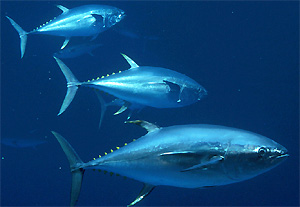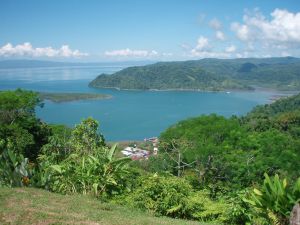Tuna farm planned in Golfito - now cancelled
In September 2005, the Costa Rican company Granjas Atuneras de Golfito S.A. asked the Ministry of Environment MINAET for a concession to use waters of the Pacific ocean at a distance of some 300 meters from the coast near the town of Golfito for the cultivation of yellowfin tuna (Thunnus albacares). Prior thereto on 19 August, 2005, the National Environmental Technical Secretariat SETENA had issued the environmental license (Viabilidad Ambiental) for the project.
The company wanted to install 10 cage netts, each with a diameter of 50 meters and a depth of 22 meters and with a content of some 34,000 cubic meters. The tuna was to be caught in weight 30 to 80 kilos with big encircling standing netts (so-called purse-seine fishing) at 50 to 250 miles away in the ocean and then dragged in these netts, at a speed of 3-5 km/h for up to 45 days, to the cages. There, they would be fed for about two to three months until they weigh some 200 kilos at which time they are killed. In this way, 3,600 metric tons of live tuna were expected to be produced each year.



Various environmental ngo's such as PRETOMA (www.tortugamarina.org), Vida Marina (http://vidamarina.org/home.htm), Fundación Keto (http://www.fundacionketo.org) have raised strong objections against this project. Their arguments are:
- The yellowfin tuna is on the IUCN 2008 Red List of Threatened Species. In July, 2011 IUCN classified five of the eight species of tuna in the Threatened or Near Threatened category. The yellowfin tuna is in the latter category meaning that it is close to being at serious risk of extinction. The situation of the bluefin tuna is worse, it is at risk of total collapse, i.e. without drastic and urgent action the species will never recover.
- The understaffed environmental authorities of Costa Rica cannot exercise sufficient control, e.g. to ensure that far out in the ocean tuna of less than 30 kilos are not caught;
- large quantities of sardines estimated at 20,000 tons per year will have to be imported from as far as Chile to feed the tuna. The diet will be monotonous and cause stress and diseases to the tuna (as has happened in Australia);
- 20 kilograms of alimentation is needed for every 1 kilo of fattened tuna;
- the massive generation of the metabolic waste in the form of nitrates and phosphates and other contaminants can cause excessive growth of algae and eutrofication of the water of the Golfo Dulce, one of the five tropical fjords in the world;
- since the Golfo Dulce is deeper in the center than at the mouth, waste streeming inside will sink to the bottom and not flow out to the sea;
- the nightly illumination of the cages will cause disturbance to migrating whales, turtles and other marine species;
- the cages may cause other marine animals such as whales and dolphins to get trapped, or their migration routes disturbed; young turtles will swim into the netts and get eaten by the tuna;
- the metabolic waste may affect the nearby beach areas where the endangered Olive Ridley turtles lay their eggs;
- in the third year of the project, forecasted revenues were $ 17.000.000 but only $ 144.000 would be paid for salaries for local staff.
In July, 2006 various nog's presented a motion of objectives with the Constitutional Chamber of the Supreme Court of Justice against SETENA (which had issued the license) and MINAET (which gave the concession to use the waters of the Golfo Dulce).
On 9th May, 2007 the Constitutional Court ordered the suspension of the project until SETENA could guarantee, and with reasonable certainty, that the metabolic waste produced by the fattening of tunas would not contaminate the environment, particularly the Golfo Dulce. SETENA had to undertake the necessary technical studies to determine the direction and movement of the currents and the effect of the metabolic wastes on the Golfo Dulce.
On 5th November, 2008 SETENA issued a resolution recommending that the project continue, based on the existing environmental study and other documents and an additional report by CIMAR (the Center for Marine and Limnological Research) which was prepared in just 11 days in September 2008. Various ngo's such as PRETOMA questioned the content of the report as it does not satisfactorily deal with the questions about the ocean currents carrying the waste of the farms and the impact on nearby nesting sites of the endangered Olive Ridley sea turtles. On 11th November, PRETOMA filed a lawsuit against SETENA and an appeal to MINAET about the report. On 16 February, 2009 SETENA rejected PRETOMA's lawsuit. In September, 2010 SETENA extended the environmental license for the project.
Nevertheless, when the case came up to the Supreme Court of Justice, this Court ordered SETENA to cancel the extension of the license. On 7 November 2011 SETENA followed-up the order of the Court, canceled the license and archived the file.
Sustainable fishing of tuna is also possible: in September, 2007 the Marine Stewardship Council (MSC) certified the American Albacore Fishing Association of San Diego, California with its 21 vessels which apply strict methods to avoid overfishing and bycatch of albatrosses and other seabirds, seaturtles, sharks and other fish.
Sustainable fishing is a must now: the world's tuna fisheries whose export catch in 2002 was valued at $ 5 billion, face severely declining stocks and various of the 23 commercially exploited tuna stocks are heading to become critically endangered or even extinct.